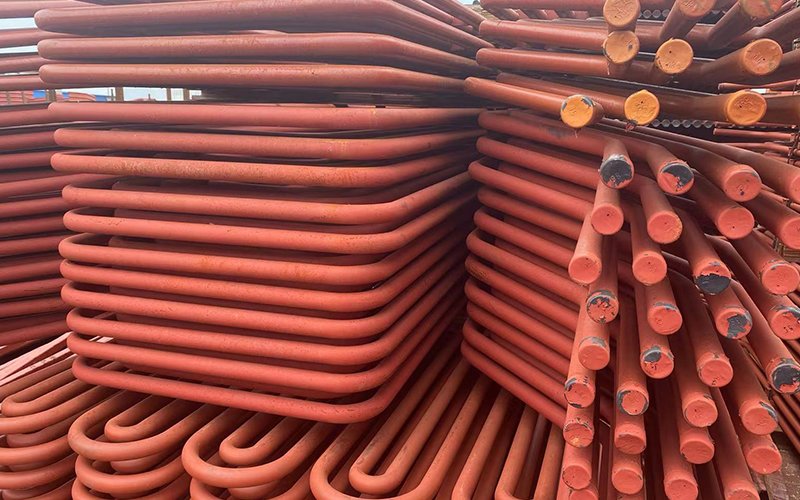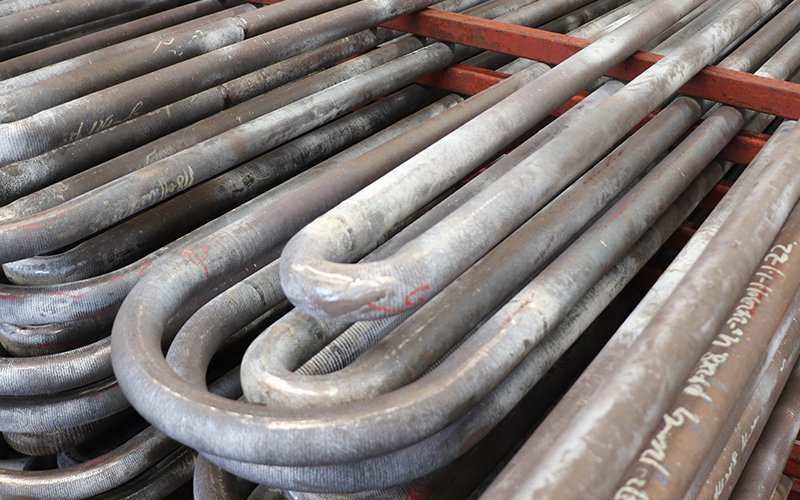Manufacturing steam superheaters has been quite a challenge due to high rework rates and difficulties in meeting delivery schedules. To tackle this issue, we’ve embraced lean thinking with a focus on enhancing efficiency and cost reduction. Our approach involves identifying, measuring, analyzing, and improving issues systematically, using the DMAIC tool to find effective solutions.
Our steam superheaters are renowned in the petrochemical market, known for their tight manufacturing cycles and complexity. The tube box component is a thick-walled forging with a nickel-based NO6600 structure, while the heat exchanger tube is crafted from nickel-based NO6690 material. It features numerous large-sized threaded holes and fasteners that require hydraulic tensioners for tightening. Since we lack extensive experience in producing such equipment, and the production timeline is quite lengthy, meeting steam superheater contracts on time has been a significant challenge. Optimizing the product structure and production process will play a pivotal role in helping us fulfill our steam superheater contracts effectively.

Analysis of steam superheater process measurement problems
1.1 Process analysis
Let’s dive into an analysis of the steam superheater process measurement problems. Taking a closer look at the project in light of its product structure, we’ve identified key quality control points, and we’ve come up with a rapid improvement plan, as outlined in Table 1.
(1) Key Quality Control Points:
- Machining after forging entry into the factory
- Forging surfacing and flaw detection
- Weld heat treatment and hardness inspection
- Hydrostatic testing
- Assembly of internal parts
(2) Existing Bottleneck Processes:
- Low machining efficiency for forgings upon entering the factory
- Lengthy material procurement cycle for welding of forgings
- Low success rate of hydrostatic testing
- Difficulty in tightening large bolts
(3) Direction of Improvement:
- Standardize forgings
- Determine the form of weld heat treatment
- Create special hydraulic tensioners
(4) Main Improvement Plan:
- Optimize the product structure while maintaining its structural performance
- Reduce non-essential processing steps to eliminate waste
- Streamline the process flow, minimizing cross-workshop transfers and handling waste
- Make efficient use of production equipment, enhancing the capacity of CNC machine tools to reduce over-processing
- Identify bottleneck processes in the production and manufacturing process, and work on shortening their time or advancing their nodes
By analyzing the manufacturing process and pinpointing bottleneck processes, we aim to cut down on the production cycle of our primary product line and eliminate waiting waste.
Table 1: Rapid Improvement Analysis Table
| Identify Opportunities | Specifics | Cause Analysis | Quick Improvement |
|---|---|---|---|
| Waste | All large bolt holes are machined using CNC boring. | Bottom holes are processed using rocker arm drilling, reaming, and tapping using CNC boring to eliminate over-processing and improve CNC boring utilization. | The machine processing sub-factory is canceled, resulting in tight outsourcing resources. |
| Waste | The original petrochemical vessel had fewer large bolt holes, which had less impact on planned scheduling. | Waste Pipe range forgings are machined after entering the plant. | Fully utilize the resources of machining in the forging manufacturing plant to raise semi-finished forgings and reduce the workload of machining in the plant. |
1.2 C&E Matrix: Screening Key Factors
After a detailed flow chart analysis, we’ve employed the C&E matrix to identify key factors for various processes, such as sealing surface and threaded hole machining, shell preparation, cylinder rolling, internal parts machining, N1 receiver lower end finishing machining, shell welding, pipe process assembly preparation, pipe box assembly welding, shell heat treatment, pipe process assembly heat treatment, hydraulic testing, and internal parts assembly. Summing up the key processes identified through the C&E screening, they include N1 receiver lower end machining, sealing surface and threaded hole processing, and hydraulic testing.
Problem analysis of steam superheater
Let’s get into the analysis of the problems related to steam superheaters, looking at both cost and process aspects.
2.1 Cost Analysis
Our steam superheaters are designed for high-temperature corrosive media heat transfer, and they use nickel-based materials for heat transfer tubes. These materials come at a premium, making the unit cost quite expensive. Previously, we adopted a method where various R materials were kept as spare tubes due to differences in gauge and straight length for each piece of equipment. However, this led to a significant amount of waste, as these tubes couldn’t be reused.
In the case of the N1 receiver, which connects to the gasifier, a one-piece flange is required, and we need high-grade materials for water pressure end caps to ensure safety. Unfortunately, these materials come at a considerable cost. We’re exploring alternative methods to reduce expenses.
2.2 Process Analysis
The in-plant processing of the pipe process receiver forging significantly impacts the progress of the primary pipe process. Originally, the N1 takeover route involved eight transfers, which proved to be excessively lengthy and inefficient.
2.3 Critical Factor Analysis for C&E Matrix Screening
For finishing the lower end of the N1 receiver, the key factors include:
- Lifting and placing the workpiece
- Centering the workpiece and preparing the tool
- Selecting machining parameters and loading the tool
- Roughing milling
- Finishing milling
- Checking roughness and dimensions
- Transferring the workpiece
Analyzing sealing surface and screw hole machining, the key factors are:
- Lifting and placing the workpiece
- Workpiece alignment and tool preparation
- Machining the sealing surface
- Measuring the thickness of the cladding layer
- Milling the bottom hole of the bolt hole
- Milling bolt hole reaming
- Milling bolt hole threads
- Checking with plug gauges
- Transferring
In the hydrotest process, key factors include:
- Lifting and placing products
- Preparing tools and fixtures
- Installing bolts
- Installing end caps
- Installing gaskets and nuts
- Tightening with hydraulic tensioners
- Hydrotesting
- Passing the hydrotest
- Transportation
By identifying these key factors, we can better streamline our processes, reduce waste, and work towards more cost-effective solutions in the production of steam superheaters.

Improvement of steam superheater problems
3.1 Cost Reduction
We’ve taken a proactive approach to reduce costs. By brainstorming and examining the picking gauge intervals, we’ve identified an opportunity to carry out material reformation. We’ve shifted from using large bending radii to smaller ones and prepared for pipe bending. This has allowed us to eliminate the need for balancing the heat exchanger tube and re-producing it. When the picking gauge, heat exchanger tube diameter, and wall thickness match, we’ve opted not to mention the production of heat exchanger tube preparation. This has significantly reduced the weight of material to be lifted, prevented inventory buildup, and resulted in substantial cost savings.
For the N1 receiver bolts and nuts, we’ve typically purchased fasteners with the equipment. However, these fasteners didn’t always align with the plant’s water pressure requirements, and there was a risk of fastener damage. To address this, our project team brainstormed a solution. We’ve now implemented the use of product fasteners, reformed our tooling, and maintained two sets of fasteners for spare parts. After hydrostatic pressure testing, we subject these fasteners to a 100% MT test, ensuring they meet our requirements. These changes have allowed us to use large-diameter high-grade material fasteners efficiently and cost-effectively.
3.2 Process Optimization
The N1 takeover route was previously marked by excessive transit, with a total of eight transfers. After extensive discussions and demonstrations, we’ve optimized the route flow, reducing transit from 8 times to 5 times. Moreover, we’ve maximized the use of machining resources in the forging plant, thereby reducing the workload on the CNC boring machine in the plant. This optimization has significantly improved the progress of the main pipe box assembly.
3.3 Improvement Plan for Key Factors in C&E Matrix
In the case of the N1 receiver lower end, where Cr-Mo surfacing nickel-based tolerance requirements need to be met, we initially struggled due to our lack of experience with nickel-based material machining. This led to tool wear and inadequate surface roughness. After consultations and testing, we’ve identified the optimal machining parameters for nickel-based materials, which include a speed of 45 r/min, a feed of 5 mm, and a draft of 1.5 mm. These parameters have not only improved machining efficiency but also enhanced the quality of machining while reducing costs.
Analyzing the hydrotest process, we found that the hydraulic tensioner was a key step. However, different projects had different sizes, and the existing tensioner’s applicability was poor, resulting in hydraulic leakage issues. To tackle this problem, we provided on-site guidance and produced a new hydraulic tensioner that covers a range of M48 to M110 bolts. This solution ensures that the same type of products can be used in the future, even under tight deadlines.
When analyzing the process flow of sealing surface and threaded hole machining, we recognized an opportunity for rapid improvement. While rework chances were minimal in this process, it did consume a lot of time on CNC machines. We meticulously reviewed each step to identify processes that could be replaced by common machine tools. The final decision was to switch the milling of the bottom holes of the bolt holes to a rocker arm drilling machine, effectively eliminating the waste of transitional processing.
In conclusion, the effective implementation of lean improvements in steam superheater process manufacturing technology has demonstrated remarkable results. By utilizing a range of lean tools, we’ve made significant strides in optimizing the steam superheater manufacturing process. These improvements have not only enhanced processing and manufacturing efficiency but have also substantially reduced production costs, all while maintaining the highest product quality standards.
Through a continuous process of improvement and optimization, we’ve not only lowered production costs but have also achieved a notable increase in on-time product deliveries. This has solidified our company’s position as a leader in this product field, further enhancing our competitive advantage. Moreover, the experience gained through this lean improvement process serves as a valuable resource for future enhancements in subsequent products. We are committed to building on this success to drive continuous improvement and innovation throughout our manufacturing processes.
DHB Boiler
Discover The Superior Quality And Cutting-Edge Technology Of DHB Boilers. Explore Our Range Of Biomass Boilers, Waste Heat Boilers, And More. Take Your Industrial Operations To New Heights With DHB Boiler.








